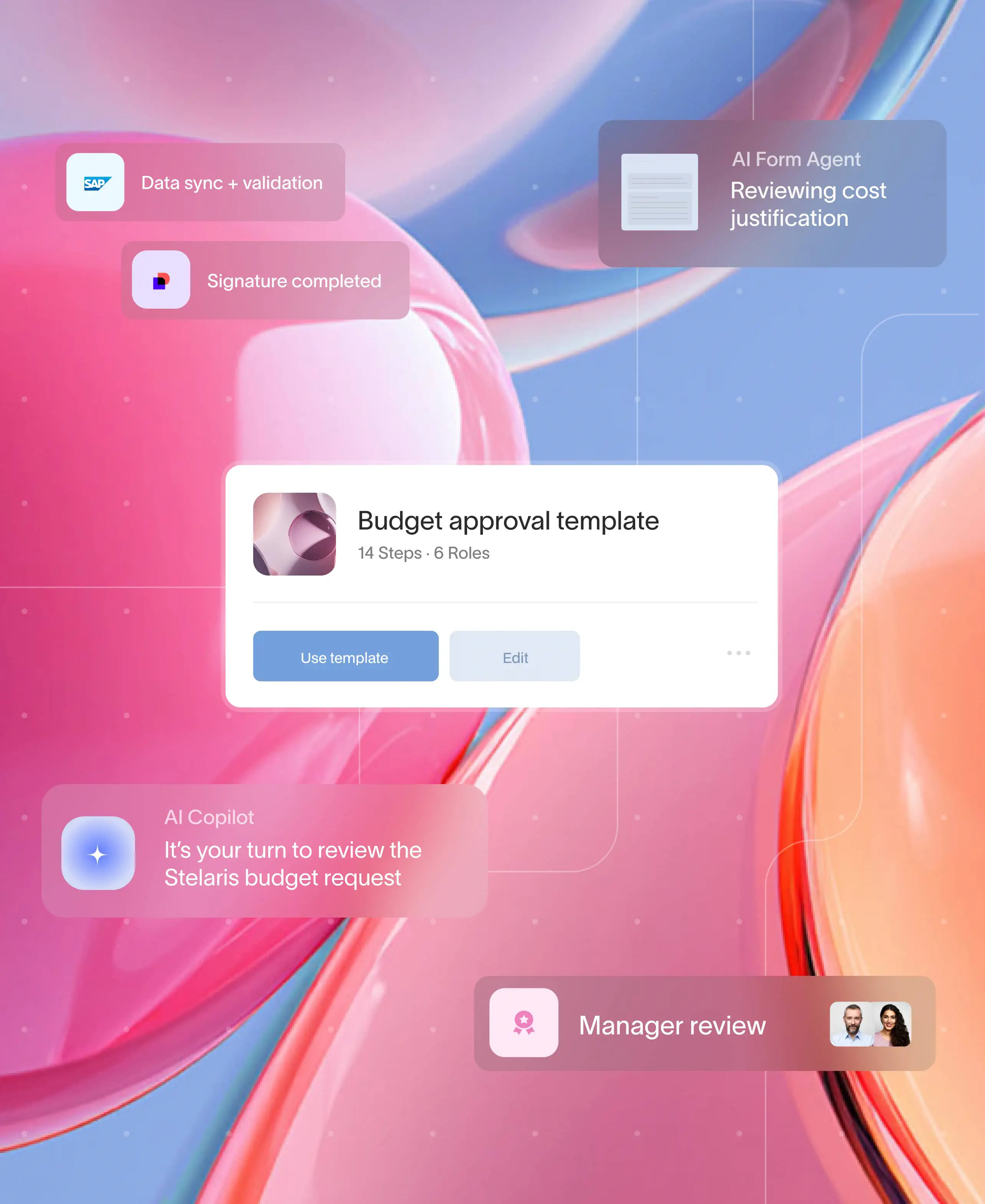
In today’s fast-moving business landscape, automation is no longer optional — it’s essential. But traditional automation has limitations, especially when processes involve judgment, exceptions, or collaboration. That’s where Intelligent Process Automation (IPA) comes in.
A core benefit of IPA is its ability to automate repetitive tasks, such as data entry and document processing, which traditional automation often struggles with.
IPA combines the power of AI, machine learning, and robotic process automation (RPA) to streamline business operationsin a smarter, more adaptive way. In this guide, we’ll break down what intelligent process automation is, how it works, and why it’s changing how organizations operate.
What is intelligent process automation?
Intelligent Process Automation refers to the use of AI technologies like machine learning, natural language processing, and decision engines — layered on top of traditional automation — to manage complex business processes.
Unlike rule-based automation, IPA can adapt, learn, and handle non-linear, human-in-the-loop workflows that require judgment or cross-team coordination. The intelligent automation process integrates AI, RPA, and machine learning to streamline and improve digital workflows across the organization.
Intelligent process automation definition:
A technology framework that combines AI, robotic process automation (RPA), and business process management (BPM) to automate, optimize, and orchestrate workflows across an organization.
While business process automation focuses on automating rule-based, repetitive tasks, intelligent process automation leverages advanced technologies such as AI, machine learning (ML), natural language processing (NLP), and process mining to handle more complex, adaptive workflows and unstructured data across enterprise processes.
How intelligent process automation works
At its core, IPA integrates several technologies:
- Robotic Process Automation (RPA): Automates repetitive, rules-based tasks.
- Artificial Intelligence (AI): Adds cognitive capabilities — such as decision-making or document classification. Cognitive technologies, such as natural language processing and computer vision, enable IPA to perform more sophisticated tasks beyond basic automation.
- Machine Learning (ML): Enables the system to learn from data and improve over time. Optical character recognition (OCR) is often used in IPA to extract data from unstructured sources like scanned documents and images.
- Business Logic: Connects the automated components with real-world process logic and exceptions.
Together, these enable smart process automation — not just task-level automation, but full-process orchestration across departments, teams, and even systems.
Examples of IPA and robotic process automation technology components:
- IPA robotics: Automate tasks like data entry, invoice processing, or form validation.
- IPA software: Integrates with tools like ERPs, CRMs, and custom platforms. Many organizations struggle to integrate IPA with existing tools, which may be outdated or unable to support complex workflows, highlighting the need for modern, flexible platforms.
- IPA process workflows: Adaptable, rule-driven, and often include AI agents and humans in the loop.
Benefits of intelligent process automation
The rise of intelligent business automation is driven by clear, measurable benefits: increased productivity, greater efficiency, improved customer experience, cost reduction, and better decision-making. These benefits of intelligent automation help organizations streamline high-volume or repetitive tasks, allowing employees to focus on more strategic activities.
1. Efficiency gains
IPA streamlines manual processes and routine tasks, reducing time spent on repetitive work.
2. Scalability
It allows businesses to handle more volume without increasing headcount.
3. Improved accuracy
AI and automation reduce errors in data handling and decision-making.
4. Enhanced collaboration
IPA enables human-in-the-loop workflows, allowing humans to step in where exceptions or approvals are needed.
5. Better visibility
Integrated process tracking and analytics deliver insights across the business.
Decision-making and optimization in intelligent process automation
Intelligent process automation (IPA) is transforming how organizations approach decision-making and process optimization by combining advanced technologies such as robotic process automation (RPA), artificial intelligence (AI), and machine learning (ML). By automating repetitive tasks and leveraging data-driven insights, IPA empowers businesses to make faster, more accurate decisions and optimize their business processes for maximum efficiency.
One of the core strengths of IPA lies in its ability to automate manual tasks—like data entry, invoice processing, and routine customer service interactions—using software robots. This not only reduces the risk of human error but also allows employees to focus on more complex tasks that require human intelligence and creativity. By automating repetitive manual tasks, organizations can enhance efficiency, lower operational costs, and improve overall business operations.
IPA goes beyond simple task automation by utilizing natural language processing (NLP) and computer vision to analyze unstructured data, such as emails, documents, and images. These intelligent automation tools can extract valuable information from a variety of sources, enabling businesses to gather data that was previously difficult to access or analyze. For example, insurance firms can use intelligent document processing to automate claims handling, while logistics companies can analyze shipping data to optimize shipping routes and schedules, reducing delays and improving customer experience.
A key advantage of intelligent process automation is its ability to drive data-driven decision making. By analyzing historical data and applying machine learning algorithms, IPA can identify patterns, predict future outcomes, and recommend process improvements. This enables organizations to continuously optimize existing processes, streamline complex workflows, and respond proactively to changing business needs. In industries like finance and insurance, IPA can automate digital processes such as fraud detection and risk assessment, providing significant benefits in terms of accuracy and speed.
IPA also integrates seamlessly with existing systems and business process management (BPM) platforms, allowing organizations to automate digital processes without overhauling their IT infrastructure. This flexibility makes it easier to scale automation across departments and adapt to evolving business requirements. As digital process automation becomes more prevalent, businesses can orchestrate complex processes that involve both human intervention and automated workflows, ensuring optimal outcomes with minimal manual effort.
Emerging technologies like cognitive automation and blockchain are further expanding the capabilities of IPA. Cognitive automation leverages AI and ML to handle more complex tasks that mimic human reasoning, while blockchain can add transparency and security to automated workflows. These advancements are enabling organizations to automate tasks that were once considered too complex for traditional automation technologies.
To successfully implement intelligent process automation, organizations should start by identifying areas where automation can deliver the greatest value—such as automating repetitive tasks, optimizing business processes, or enhancing customer experience. By evaluating the potential benefits, including reduced operational costs, improved accuracy, and increased operational efficiency, businesses can build a strong case for IPA adoption and gain a competitive advantage in their industry.
In summary, intelligent process automation is a powerful enabler of smarter decision-making and process optimization. By harnessing the power of RPA, AI, machine learning, and other automation technologies, organizations can automate tasks, analyze large volumes of data, and continuously improve their business processes. As IPA continues to evolve, it will play an increasingly vital role in driving operational efficiency, improving customer experience, and supporting data-driven decision making across all sectors.
Use cases and examples
Intelligent process automation is used across industries to transform workflows, with intelligent automation use cases spanning healthcare, finance, retail, manufacturing, and logistics. Here are a few common examples:
- Finance: Automating reconciliation, expense processing, and KYC compliance.
- HR: Streamlining employee onboarding with smart document collection and approvals.
- Operations: Managing vendor onboarding, SOP rollout, and compliance workflows.
- Customer service: Enhancing response routing and case handling using AI-driven triage. Intelligent automation work can automate the collection and updating of customer data from sources like emails and phone calls, reducing the workload for customer service reps and improving data accuracy.
These aren’t just RPA bots doing repetitive tasks. The intelligent automation process orchestrates adaptive workflows that combine AI, machine learning, and automation technologies to enable smarter, more autonomous business functions.
Popular intelligent process automation tools and platforms
Many companies are investing in intelligent process automation solutions to transform their business. Some leading platforms include:
Moxo
Moxo is uniquely positioned as a business orchestration platform built for human-in-the-loop workflows. It enables businesses to automate multi-step, multi-party processes — while ensuring stakeholders across departments, clients, or vendors can collaborate in context.
- Ideal for client onboarding, vendor management, and operations workflows
- Offers built-in business actions like form fills, approvals, document collection, e-signatures, and messaging
- Supports integration with CRMs, ERPs, and other transaction systems
- Excels in industries where human judgment and compliance are essential
Moxo brings structure and automation together — making it easier to scale complex processes without losing the human connection.
Other tools include:
- UiPath: Known for RPA and machine learning integrations.
- Automation Anywhere: Focusing on digital workers and cognitive automation.
- Blue Prism: Enterprise-grade RPA with AI connectors.
- IBM Process Mining & Automation: Offering analytics-driven automation.
- Microsoft Power Automate: Integrating with the Microsoft ecosystem for task automation.
How to get started with intelligent process automation
Here’s how to begin implementing IPA in your organization:
- Identify repetitive, manual, or error-prone processes.
- Map out where decisions or exceptions occur.
- Choose an IPA platform that supports both system automation and human collaboration.
- Build a pilot workflow, starting small but representative of your broader business needs.
- Expand based on results, adding automation layers and reporting.
Working with intelligent process automation companies can accelerate this journey, especially those with prebuilt templates or vertical expertise.
Conclusion: The future of process automation is intelligent
Intelligent process automation is no longer futuristic — it’s here, and it’s essential. As businesses grow more complex, the ability to automate processes intelligently — with people, AI, and systems all working in sync — becomes a strategic advantage.
Whether you're improving client onboarding, streamlining vendor workflows, or accelerating approvals, IPA helps you handle more with less, while maintaining control and context.
And with platforms like Moxo, you don’t just automate. You orchestrate.





